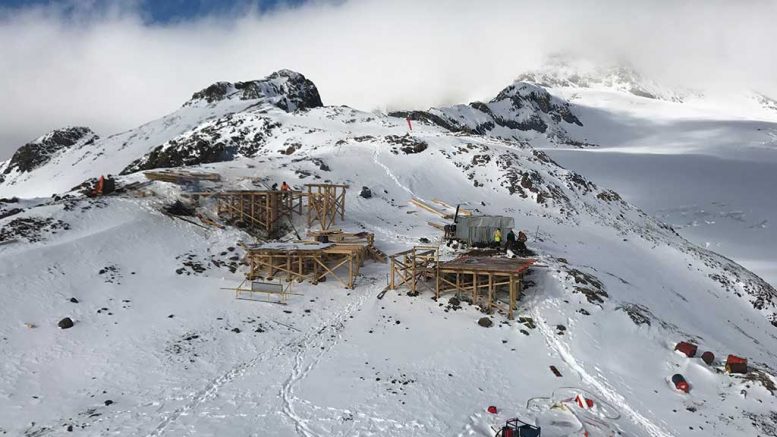Broadly speaking, 2017 was a year of renewed optimism for many miners and mineral explorers, fuelled by stronger commodity prices and long awaited financial payoffs from belt-tightening measures taken during the 2012–2016 downturn in mining markets.
Let’s take a look at some of the top mining stories over the past year.
8. Rise of cryptocurrencies — This was the year mining executives and investors could no longer ignore the growing appeal of cryptocurrencies among a niche group of retail investors that would probably be gold bugs in years past.
As gold prices stayed flat for much of the year below US$1,300 per oz., cryptocurrencies such as bitcoin had exceptional years, with bitcoin starting the year around US$1,000 and rising past the US$18,000 mark by mid-December.

Autonomous haulage trucks on the move at Rio Tinto’s West Angelas iron ore mine in Australia’s Pilbara region. Credit: Rio Tinto.
7. Technological innovation — If there was one theme that emerged at various mining conferences around the world in 2017, it was a renewed emphasis on technological innovation in mining operations. Miners were keen to show off their multitude of innovation initiatives, from remote control systems and next-level information technology at mine sites to plans for electric vehicle mining fleets and solar panel arrays.
6. Stumbles and belly flops — While a few years ago it was the major miners that filled the industry’s penalty box due to monumentally poor corporate decision-making, 2017 was a year for the smaller miners to make headlines with major operational problems, including TMAC Resources’ rocky ramp-up at its new Hope Bay gold mine in Nunavut; Asanko’s reserve estimation problems in Ghana; Tahoe Resources’ recurring social headaches in Guatemala; and Acacia Mining’s gong show in Tanzania, where the government has not proved credible in its accusations that the gold miner was hiding its true production numbers.

The Doris camp at TMAC Resources’ Hope Bay gold project in Nunavut. Credit: TMAC Resources.

The processing plant at Asanko Gold’s Nkran gold mine in Ghana. Credit: Asanko Gold.

Barrick Gold executive chairman John Thornton (left) and Tanzanian President John Magufuli meet in Dar es Salaam, Tanzania, on June 14, 2017. Credit: Office of the president of Tanzania.

Yukon Premier Sandy Silver at the podium in Whitehorse, Yukon, on Sept. 2 to announce the $360-million Yukon Resource Gateway Project to improve roads in the Yukon, with Prime Minister Justin Trudeau (right) and Yukon Member of Parliament Larry Bagnell. Credit: CP.
5. Key roads promised in Yukon, Ontario — While one is never sure how much faith to put into a government promise, mineral developers active in the frontier regions of the Yukon and northern Ontario rejoiced in government funding announcements for long-awaited road developments that would benefit future mine construction and mineral exploration. In the Yukon, the territorial and federal governments pledged $360 million for road construction while in Ontario’s roadless Ring of Fire region, the provincial government pledged support and funding for two roads into the district that could cost $1 billion.
4. Uranium production cuts — In contrast to just about everyone else in mining who has been enjoying better times, the uranium subsector continued to wallow in the bear market initiated by the Fukushima nuclear in 2011, with uranium oxide prices down 70% since then. There were three fresh waves of massive production cuts in 2017: Kazatomprom slashed 20% of its output in January; Cameco suspended 40% of its production in November; and Kazatomprom returned in December with a pledge for another 20% reduction.

Workers with cans of yellowcake. Credit: Kazatomprom.
3. New zinc plays as base metals prices rally — While gold, iron ore and metallurgical coal were the surprise darlings of 2016, this year was time for the base metals to continue their strong rally that started in mid-2016. The rebounding zinc price translated to a host of new or revived zinc plays such as Canadian Zinc in the Northwest Territories, Titan’s restoration of Balmat in New York state and Votorantim’s spinoff and listing of Nexa Resources.

Canadian Zinc’s Prairie Creek zinc-lead-silver project, 500 km west of Yellowknife in the Northwest Territories. Credit: Canadian Zinc

The administration building in front of the headframe at Titan Mining’s Empire State zinc project in upstate New York. TITAN MINING
2. Lithium and cobalt boom — The rapid rise in electric vehicle usage captured the imagination of millions of investors globally, who pushed the market capitalization of Elon Musk’s Tesla Motors to a dizzying height of US$55 billion on revenue in 2016 of only US$7 billion. In mining the EV excitement translated into a boom for junior companies actively searching for metals such as lithium and cobalt that are needed in EV batteries.

Surveying at Neo Lithium’s Tres Quebradas (3Q) lithium brine project in Argentina.
1. Canadian gold exploration soars — With gold prices stabilizing above a healthy US$1,200 per oz., the Canadian dollar weakening and the geopolitical scene looking increasingly hostile outside North America, gold exploration in Canada took on increased urgency in 2017. While activity picked up across the country, B.C.’s Golden Triangle, the Abitibi region of Quebec and Ontario’s traditional gold camps all saw heated activity in exploration drilling, production expansions, and mergers and acquisitions.

A drill rig at Colorado Resources’ KSP copper-gold property in northwestern B.C.’s Golden Triangle district. Credit: Colorado Resources.

Osisko Mining’s Windfall gold project in Quebec. Credit: Osisko Mining.



Be the first to comment on "Editorial: Top stories of 2017"